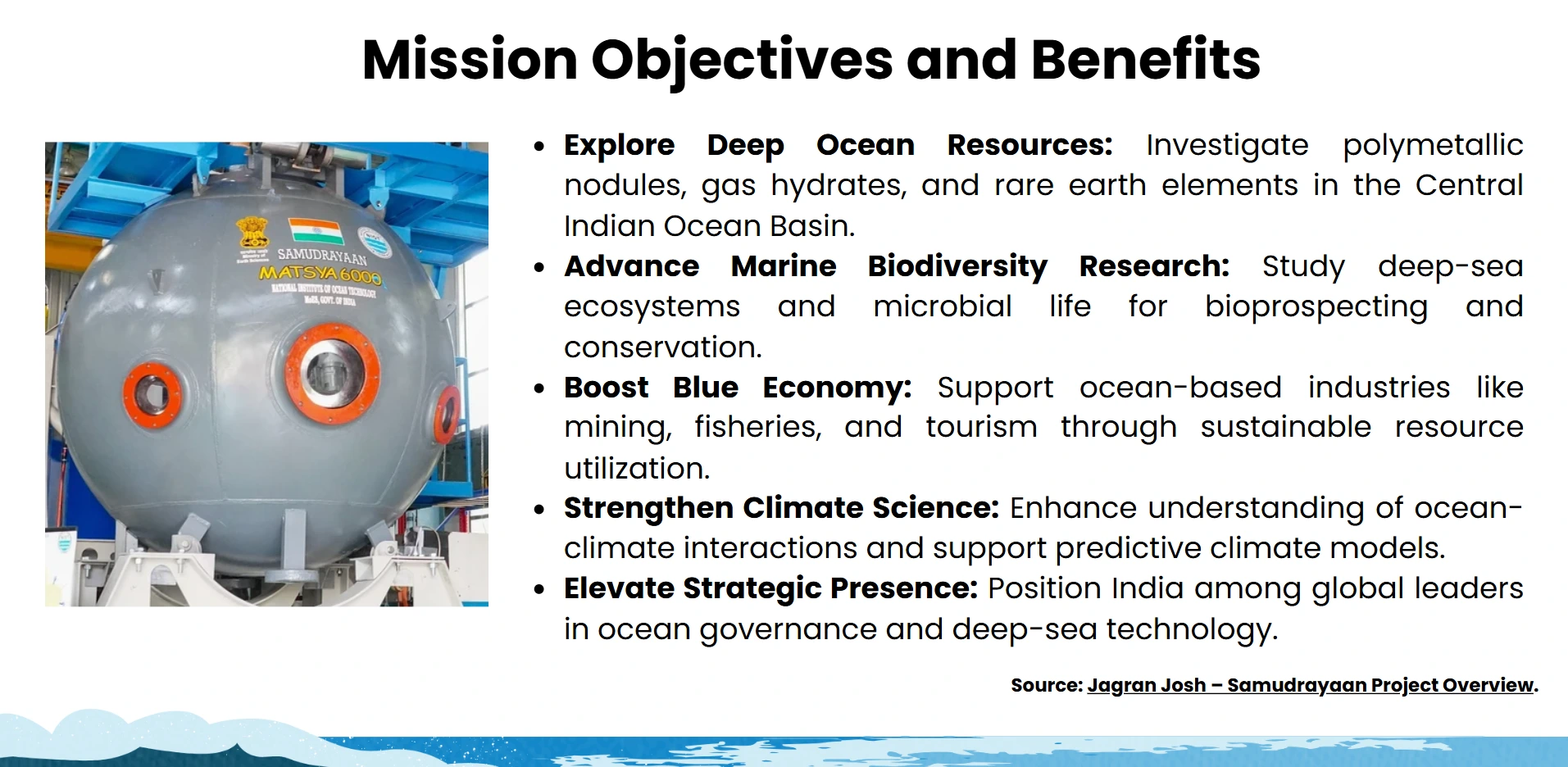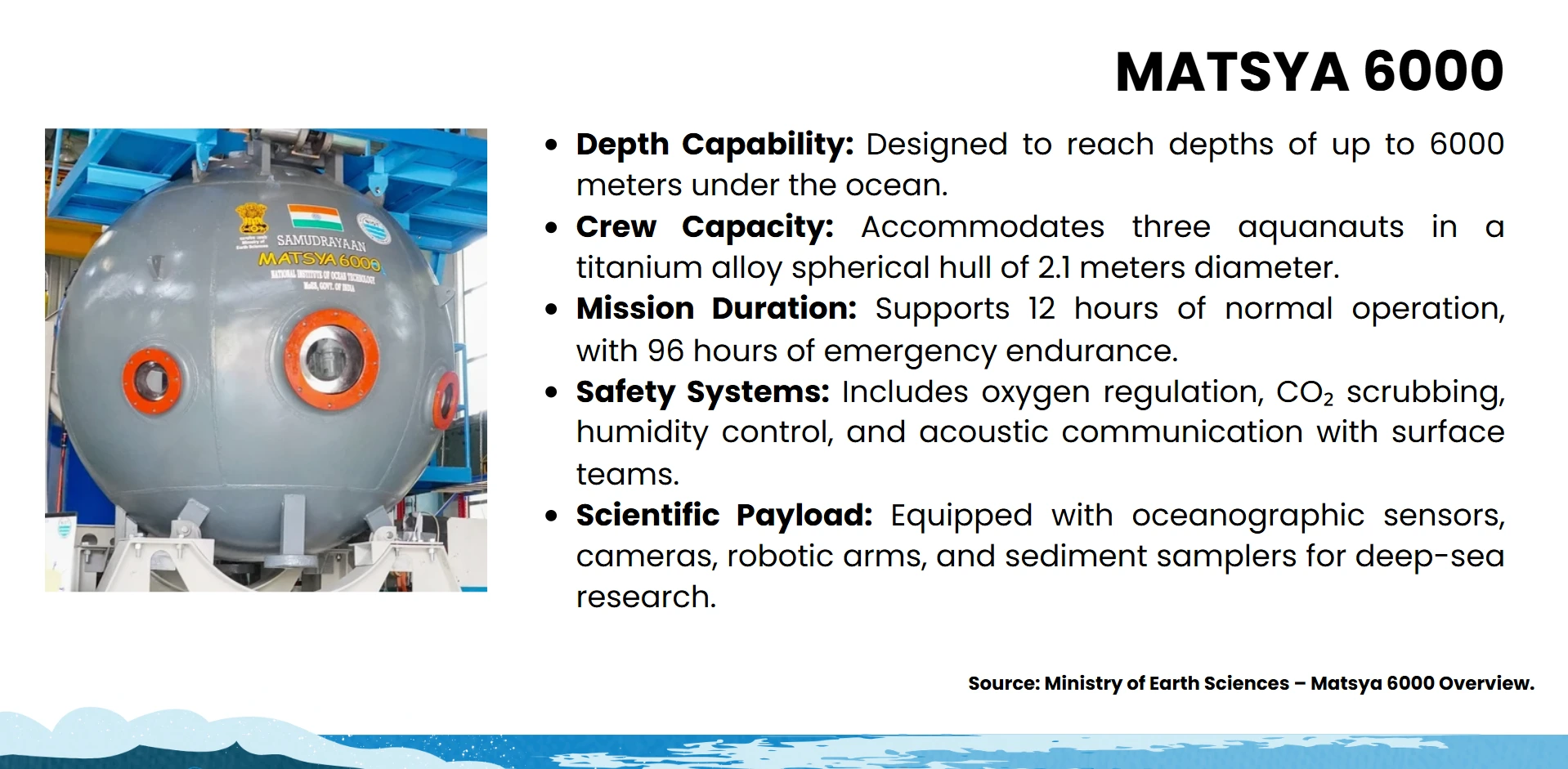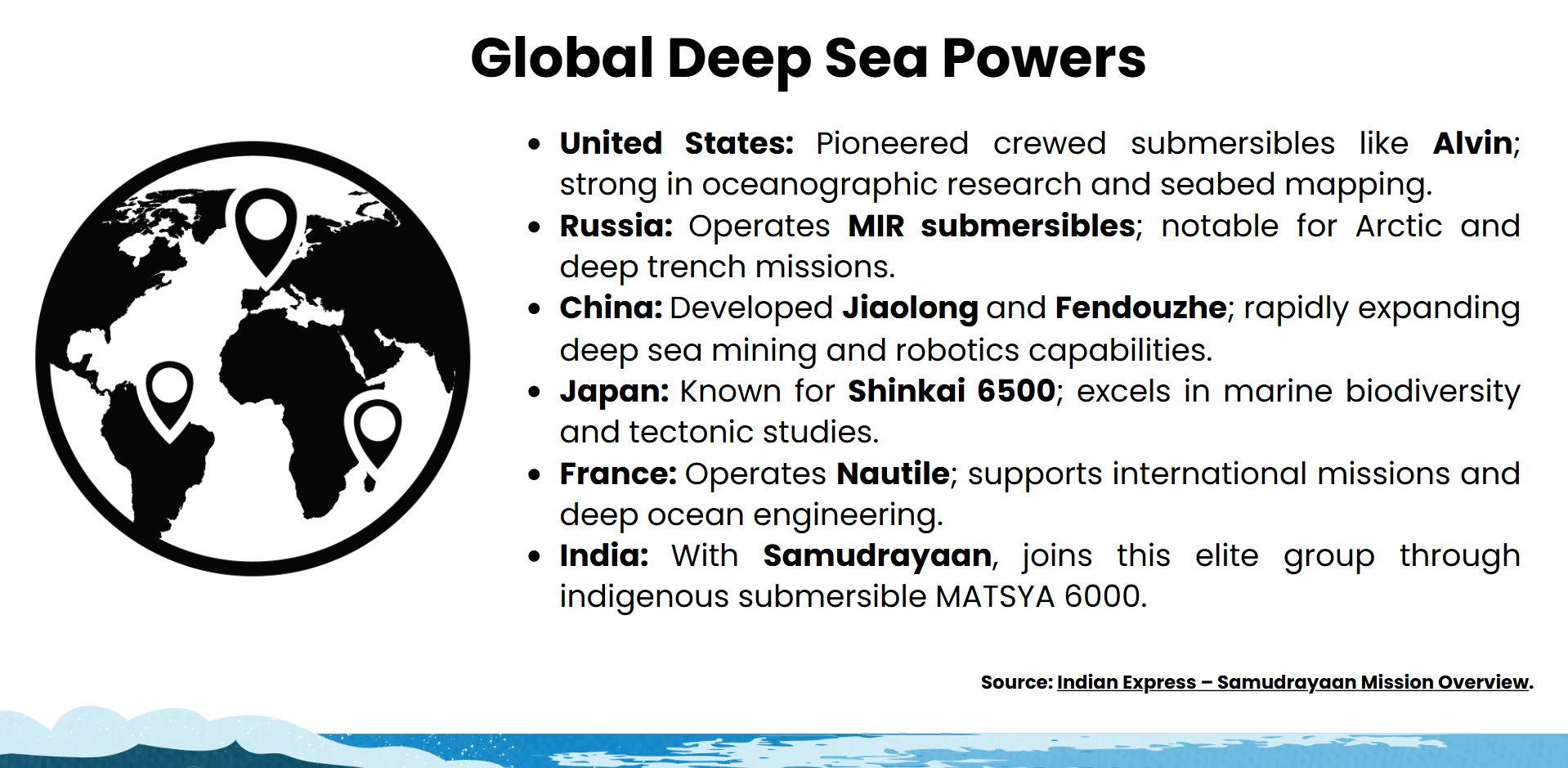The Indian Aquanauts submersible Samudrayaan missions will send out trained aquanaut scientists in the submersible of the ocean to tap into ocean resources, biodiversity, and ocean strategic depths along with the elites.

The development of Indian strategic ambitions in oceanic research and resource exploration has matured to a pinnacle point with the launch of the Samudrayaan Mission, a signature work under the Deep Ocean Mission. This is an initiative that will see India joining the exclusive club of countries, which includes the United States, Russia, China, Japan, and France, with advanced deep-sea exploration abilities. The core of Samudrayaan is an aquanaut deployment of the crewed submersible, MATSYA 6000, which would carry three aquanauts to a depth of up to 6000m in the ocean. The mission is representative of the expansion of marine science, technology self-reliance, and sustainable ocean resource exploitation in India.The Samudrayaan Mission is not only a technological product, but a multidimensional endeavour in terms of perception and exploitation of the deep sea. Such a mission covers the mapping of poly-metallic nodules, investigations of benthic ecosystems, envisioning a breakthroughinclimate science, and assuring strategic maritime interests; all tied with goals of national development. The Article looks at the long-term consequences of deep-sea exploration on the blue economy of India, its environmental responsibility and its geostrategic stand in the Indo-Pacific.
The Samudrayaan Mission: Mission and Goal
India Samudrayaan Mission is an ambitious move towards a higher strategical use of the ocean as well as a shift towards a stable interest in marine environment research in the region.
Strategic Vision and National Imperatives
The mission symbolizes India's dedication to utilizing the potential of the vastly underutilized maritime domains. The mission's objective is to conduct scientific, environmental, and financial research on the Deep Ocean, or areas below 1000 meters. It aligns with the Blue Economy policy in India as it focuses on sustainable sea-based growth and will supplement the Atmanirbhar Bharat policy in terms of how India can become self-reliant in the marine sector in terms of technology (MoES, 2021).

Science and Exploration of Resources and Mapping
A fundamental goal of Samudrayaan is to carry out in-situ exploration of Deep sea mineral resources especially poly-metallic nodules with manganese, nickel, cobalt, and copper resources. These are the resources that lie in the Central Indian Ocean Basin and are crucial to energy transition technologies and strategic industries. The mission will also support the development of marine biodiversityresearch, deep ocean climatemodelling and geophysical mapping and therefore opportunities in the study of oceanography and climate resilience initiatives.
Technological Invention and Human Presence
MATSYA 6000 is a crewed submersible, capable of reaching a depth of 6000m and running with three aquanauts on the below-sledge missions lasting up to 12 hours, which will be deployed at Samudrayaan. This is the first time that India has ever been involved in the deep sea regarding human presence, related to the achievements of other nations like the United States and China. This progress in the development of the submersible by the National Institute of Ocean Technology (NIOT) illustrates the increased ability of India to undertake high-pressure engineering, life-support system, and mission autonomy activities.
Geopolitical and Ecological Importance
Samudrayaan enhances India's advancing science and technology. It facilitates equal access to maritime resources in the seabed, fosters maritime order oversight and enhances stewardship of global waters. This mission portrays India as a responsible deep sea power with long-term interests in governance of the ocean.
The Aquanauts:Technology and Training
India has come up with a new spate of deep-sea explorers- aquanauts whose cadre is charged with the responsibility of all deep-sea explorations in shallow waters. Their training and technologicaladvances are a matter of an overlap of high science and human stamina.
Selection and Physiological Reconditioning
The physiological and psychological selection criteria reign supreme when it comes to the selection of the aquanauts that would be a part of Samudrayaan. Applicants are recruited on the basis ofscientific and engineering education, with an emphasis on the versatility in a pressurised environment and working in a closed space. Training involves the simulations in the high-pressure chambers, navigation underwater, and emergency training procedures. Some of these modules are developed with the help of agencies like the Defense Research and Development Organisation (DRDO) or the Indian Space Research Organisation (ISRO), with input based on related experiments in space and submarine missions (MoES, 2023).
Proficiency, Technical, and Mission Preparedness
Aquanauts receive vigorous training in the use of the MATSYA 6000 submersible, its life-support systems, instrumentation on board, and communication procedures. Familiarity with oceanographic instruments, robotic probes, and sampling apparatus is a necessity in the performance of the research objectives down to depths beyond 6000 meters. The training involves mission simulations as well as data logging and communication with surface control teams to ensure safety and a high level of precision during the operation in extreme conditions.
Integration of Man and Machine and Safety Systems
The MATSYA 6000 has been designed to support human life in pressurized conditions for up to 12 hours. It is designed with titanium alloyhulls, backup oxygen, thermal control, and live relay. Aquanauts are trained in handling eventualities like power failure or hull breach or navigation. Autonomous systems coupled with human decision-makers will make deep-sea missions flexible and resilient.
MATSYA 6000 Submersible
Development of MATSYA 6000 Submersible Crewed is a keystone of India advancing its ambitions into the deep sea through the Samudrayaan Mission since the vehicle is designed to work in the deepest, coldest, and harshest environments of the ocean where scientific expeditions must be multidisciplinary in nature.

Design Capabilities and Structural Capabilities
NIOT designed it to work to a depth of up to 6000 meters, submerging in the waters where pressure is more than 600 times that of sea level. The submersible is shaped, with a spherical crewmodule made of titanium alloy due to its high strength-to-weight ratio and high resistance to corrosion. This is pressure-resistant and guarantees structural integrity and the safety of the crew during long-term missions in the hadal zone. Propulsion modules, trim systems, and buoyancy modules enable the machine to move precisely in the deep sea (NIOT, 2023).
Endurance of Life and Support
Submersible canlast up to 12 hours and, in an emergency, up to ninety six hours. Life-supporting mechanisms involve the production of oxygen, scrubbing of carbon dioxide, humidity, and thermal control. The inside is ergonomically outfitted to hold scientific instruments and sampling equipment, and communication interfaces. Redundant systems make the submersible resilient to individual component failure, and the real-time telemetry provides a link with the surface control to navigate the submersible and relay data.
Mass and Infrared Imaging Spectrometer
The Submersible is equipped with robotic arms, sediment samplers, oceanography sensors, and very high-resolution cameras. These tools are used in in-situ characterizationof seabed geology, mineral deposits, and benthic ecosystems. The submersible can be customized to different mission profiles such as resource mapping, biodiversity surveys, and climate data collection as a result of its modular design. Its use is a stage change of observance of the deep ocean to immediate human connection and expands the Indian ability to monitor and analyze the oceans as well as the country's ability to attack and defend.
Strategic and Scientific Implications
It is not only of technological significance, the Samudrayaan Mission has a substantial strategic and scientific implication that goes beyond resource security, environmental sustainability, and geopolitical advantage in the Indo-Pacific region.
Resource Security and Economic Potential
Samudrayaan is one of the most important strategic initiatives that focuses on the exploration of poly-metallic nodules and other seabed minerals found in the Central Indian Ocean Basin. The nodules are the sources of so-called critical metals, including cobalt, nickel, copper, and manganese, which are fundamental to the development of renewable energy, electric vehicles, and high-performance electronics. By making in-situ exploration a reality via crewed space missions, India is looking to make itself less reliant on imports, and therefore ensure long-term availability of strategic resources and boost the industrial and energy independence in the country (MoES, 2023).
Further Development of the Climate and Marine Science
The mission greatly increases the scientific research abilities of India in the deep seas. Aquanauts in the MATSYA 6000 will be gathering biology, geology, as well as chemical downstream information about previously unexplored benthic habitats. This will add to international knowledge regarding deep-sea diversity, the process of sequestering carbon and plate processes. Further, the mission aids in climate modelling due to its affordance of understanding ocean-atmosphere dynamics and deepocean currents that are central to the prognostication of long-term climate fluctuations and extreme weather events.
Geopolitical Leverage and Ocean Governance
From a strategic standpoint, the Samudrayaan project adds another capable and accountable participant in deep-sea governance. As interest in seabed mining and marine conservation continues to grow around the world, technological and human activity in the deep ocean further support India in its Philippines Sea claims to the Indian deep seabed zones determined by the International Seabed Authority. It also adds to the maritime strength of India within the Indo-Pacific, allowing a larger role in multilateral bodies that deal with ocean sustainability, security, and transparency on fair resource allocation.

Problems and Future Prospects
Although technologically ambitious and strategically important, the Samudrayaan Mission is saddled with a range of challenges that have to be overcome in whatever bid to achieve long-term staying power and scientific achievement in deep-sea exploration.
Technical and Operational Complexities
Opening up operations to such depths as 6000 meters is an enormous task. The submersible should be able to withstand high hydrostatic pressure, support life, and offer a firm communication connection with surface groups. Building and maintaining such systems would be required, and that would entail long-term investment in ultra-high-pressure materials, precision machinery, and autonomous navigation methodologies. Moreover, humanity as part of robotic systems must be tested and have a redundancy that ensures that failures do not happen at a crucial moment in the mission (NIOT, 2023).
Environmental and Ethical Considerations
Deep sea ecosystemis one of the most fragilesystems on Earth. Ecological disturbance, loss of biodiversity and upheaval of sediment are of concern with exploration and possible extraction of resources. Solutions have to be found to deal with these risks through strict environmental guidelines, environmental impact studies, and compliance with international conservation strategies. Ethics will be required to do stewardship in the deep ocean and make sure that the scientific advancement is tempered by environmental responsibility (ISA, 2022).
International Capacity and International Collaboration
Institutional capacity building to support long-term deep-sea operations is linked to the need to train dedicated staff, build inter-sector expertise and inter-agency collaboration. The success of India will solely be influenced by the long-term cooperation with scientific bodies, defense units and foreign allies. India has been participating in international platforms of ocean governance, including the International Seabed Authority, which is likely to add credibility and influence to their emergence in developing equitableexploitation of the ocean.
Future Prospects and Strategic Roadmap
The example of Samudrayaan can be used to provide leadership on a more comprehensive national blue modernisation agenda regarding ocean technology, climate resilience, and maritime security. Future missions could involve autonomous underwater vehicles, long-duration manned dives and combined ocean observatories. By placing bets in innovation and sustainability, India should pioneer and be a global leader in responsible deep-sea exploration.
Conclusion
An important step in India's deep-sea exploration is the Samudrayaan Mission, which will integrate scientific proficiency, technological requirements, and environmental sustainability. Through sending the MATSYA 6000 submersible and training a next generation of aquanauts, India will be in a position to become one of the few nations to have crewed deep ocean capabilities. The complexity of the mission, which stretches areas as varied as mapping of the mineral resources and biodiversity studies to the study of climate and marine security, enables it to be relevant to both the national development process as well as the scientific discourse of the community of nations. Though some technical, ecological, and governance challenges yet exist, the long-term success of the mission is enhanced by institutional commitment and accumulating ocean technologies India has. Samudrayaan has not only established India in the marine science frontiers, but assisted in developing meticulous and just frameworks of ocean governance. As the country explores the deepest frontiers of the ocean, it reiterates its standing as an actor with a responsible and far-looking role in taking care of global commons.